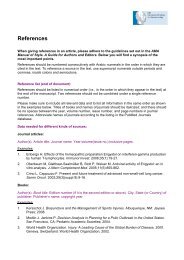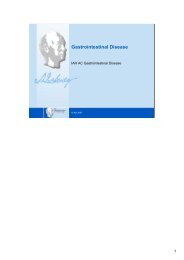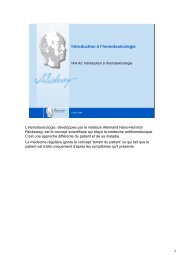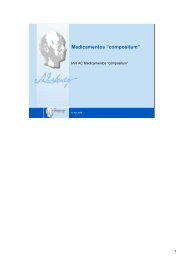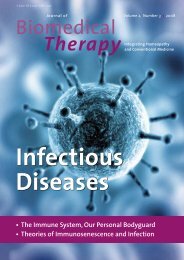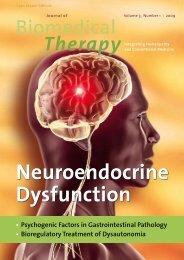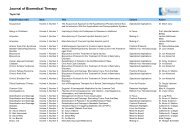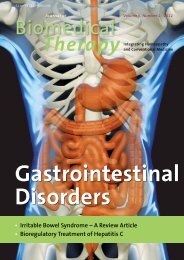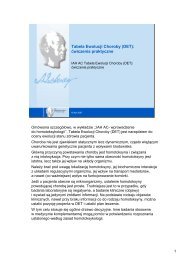Metabolic Syndrome - International Academy of Homotoxicology
Metabolic Syndrome - International Academy of Homotoxicology
Metabolic Syndrome - International Academy of Homotoxicology
Create successful ePaper yourself
Turn your PDF publications into a flip-book with our unique Google optimized e-Paper software.
) In Focus<br />
Abdominal obesity, recognized by<br />
increased waist circumference, is<br />
a risk factor for developing metabolic<br />
syndrome.<br />
© iStockphoto.com<br />
) 6<br />
Various other mediators are sourced<br />
from adipocytes, 1(p743),4 but two key<br />
ones need discussion here. First,<br />
adipose tissue-specific secretory<br />
factor (ADSF/resistin) plays a role<br />
in insulin resistance to affect adipogenesis,<br />
thereby linking obesity to<br />
diabetes. Second, the peroxisome<br />
proliferator-activated receptors<br />
(PPARa and g) are involved not<br />
only in insulin resistance and glucose<br />
and lipid metabolisms but also<br />
in inflammation (again, through<br />
NF-kB), aging, and atherosclerosis<br />
and its complications. 4<br />
Surprisingly, the skeleton is also involved<br />
in this process. It is now<br />
known that the osteocalcin produced<br />
by cells in bone “increases<br />
both the secretion and sensitivity<br />
<strong>of</strong> insulin, in addition to boosting<br />
the number <strong>of</strong> insulin-producing<br />
cells and reducing stores <strong>of</strong> fat.” 6<br />
Let us now move on to discuss antihomotoxic,<br />
integrated, naturopathic,<br />
holistic management <strong>of</strong> insulin<br />
resistance. This paper will leave<br />
aside regular exercise (aerobic and<br />
resistance) and dietary and lifestyle<br />
engineering (including cognitive<br />
behavior therapy) to concentrate<br />
on homotoxicology and nutritional<br />
engineering.<br />
Clinical relevance<br />
The net effect <strong>of</strong> insulin resistance<br />
on the organism is the accumulation<br />
<strong>of</strong> insulin and glucose in the tissues,<br />
which have detrimental effects<br />
through a number <strong>of</strong> pathways.<br />
Elevated blood glucose levels lead to<br />
activation <strong>of</strong> the polyol pathway (resulting<br />
in toxic sorbitol), auto-oxidation<br />
pathway (resulting in crosslinking<br />
via advanced glycation<br />
end products [AGEs]), protein kinase<br />
pathway (resulting in expression <strong>of</strong><br />
inflammatory mediators such as the<br />
transcription factor NF-kB), and<br />
oxygen radical pathway (resulting in<br />
NO reduction and tissue damage as<br />
well as the activation <strong>of</strong> NF-kB).<br />
The end result <strong>of</strong> these pathways is<br />
chronic inflammation, tissue destruction,<br />
and an interference in cellular<br />
processes.<br />
Antihomotoxic approach to<br />
metabolic syndrome<br />
Where does homotoxicology fit into<br />
this picture? Hans-Heinrich Reckeweg’s<br />
unique intellectual synthesis<br />
and system <strong>of</strong> medicine seems to fit<br />
metabolic syndrome like a glove,<br />
and his antihomotoxic therapy appears<br />
to have all the necessary bioregulatory<br />
and integrated holistic<br />
facets for successful management <strong>of</strong><br />
this condition.<br />
Dr. Alta Smit’s detailed protocols, as<br />
outlined in the Journal <strong>of</strong> Biomedical<br />
Therapy, stand paramount. 7 This<br />
author, however, believes that because<br />
the helenalin in Arnica “douses”<br />
NF-kB, Traumeel should be added<br />
to the initial treatment protocols,<br />
which consist <strong>of</strong> the pillars <strong>of</strong> treatment<br />
for regulating the biological<br />
terrain (through detox and drainage,<br />
cellular activation, organ regeneration,<br />
immunostimulation, and immunomodulation).<br />
The above analysis<br />
<strong>of</strong> metabolic syndrome supports<br />
the use <strong>of</strong> these medications, especially<br />
in the protocols for weeks<br />
7-12. I would add Pankreas suis<br />
(also included in Hepar compositum)<br />
and (in view <strong>of</strong> associated autonomic<br />
nervous system dysregulatory<br />
states) perhaps also Ypsiloheel<br />
and in particular Ginseng compositum<br />
as a PNETI rebalancer that simultaneously<br />
reduces gluco- and lipotoxicity.<br />
(The author is currently<br />
undertaking a practice-based study<br />
<strong>of</strong> Ginseng compositum for the annual<br />
seminar <strong>of</strong> the Society for <strong>Homotoxicology</strong><br />
and Antihomotoxic<br />
Therapy in Great Britain.)<br />
Journal <strong>of</strong> Biomedical Therapy 2008 ) Vol. 2, No. 1



